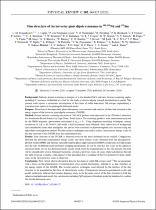| dc.identifier.citation | Donaldson, Lindsay & Carter, J. & Von Neumann-Cosel, Peter & Nesterenko, V. & Neveling, R. & Reinhard, P. & Usman, Iyabo & Adsley, P. & Bertulani, Carlos & Brümmer, J. & Buthelezi, E. & Cooper, Gordon & Fearick, R. & Förtsch, S. & Fujita, Hirohiko & Fujita, Yoshitaka & Jingo, M. & Kheswa, N. & Kleinig, Wolfgang & Tamii, A.. (2020). Fine structure of the isovector giant dipole resonance in 142-150Nd and 152Sm. Physical Review C. 102. 064327. 10.1103/PhysRevC.102.064327. | en_US |
| dc.description.abstract | Background: Inelastic proton scattering at energies of a few hundred MeV and very-forward scattering angles including
0
∘
has been established as a tool for the study of electric-dipole strength distributions in nuclei. The present work reports a systematic investigation of the chain of stable even-mass Nd isotopes representing a transition from spherical to quadrupole-deformed nuclei.
Purpose: Extraction of the equivalent photo-absorption cross sections and analysis of their fine structure in the energy region of the isovector giant dipole resonance (IVGDR).
Method: Proton inelastic scattering reactions of 200 MeV protons were measured at the iThemba Laboratory for Accelerator Based Sciences in Cape Town, South Africa. The scattering products were momentum-analyzed by the K600 magnetic spectrometer positioned at
θ
Lab
=
0
∘
. Using dispersion-matching techniques, energy resolutions of
Δ
E
≈
40
–
50
keV (full width at half maximum) were obtained. After subtraction of background and contributions from other multipoles, the spectra were converted to photoabsorption cross sections using the equivalent virtual-photon method. Wavelet-analysis techniques are used to extract characteristic energy scales of the fine structure of the IVGDR from the experimental data.
Results: Fine structure of the IVGDR is observed even for the most deformed nuclei studied. Comparisons between the extracted experimental energy scales and those energy scales obtained from the quasiparticle-phonon model (QPM) and Skyrme separable random phase approximation (SSRPA) predictions provide insight into the role of different giant-resonance damping mechanisms. It can be seen that the scales in the spherical and most likely also in the deformed nuclei mainly result from the fragmentation of the one-particle-one-hole (1p1h) strength into several dominant transitions serving as doorway states. In cases where calculations beyond the 1p1h level are available, some impact of the spreading due to coupling of the two-particle-two-hole (2p2h) states to the 1p1h doorway states is observed.
Conclusions: New virtual-photon absorption data for the chain of stable Nd isotopes and
152
Sm
are presented, with a focus on the phenomenon of nonstatistical cross-section fluctuations, referred to as fine structure, in the energy region of the IVGDR. The wavelet-analysis techniques used allowed for the features of the fine structure to be quantified in the form of characteristic scales. Comparisons between experimental results and model predictions indicate that Landau damping seems to be the main source of the fine structure in both the spherical and deformed nuclei, but calculations including 2p2h degrees of freedom would be beneficial to confirm this for the deformed cases. | en_US |

